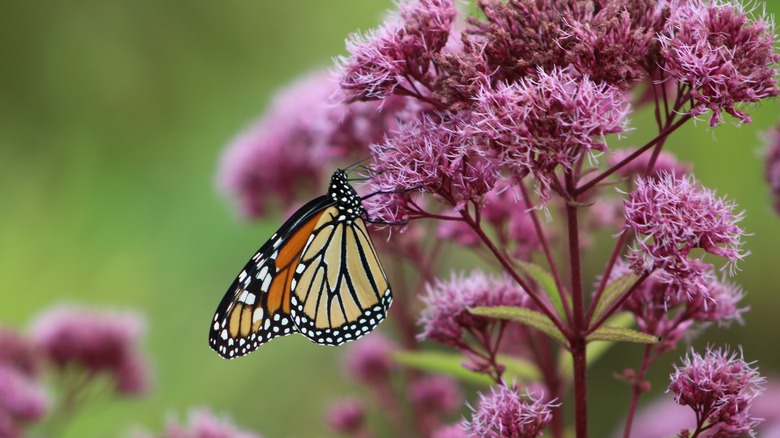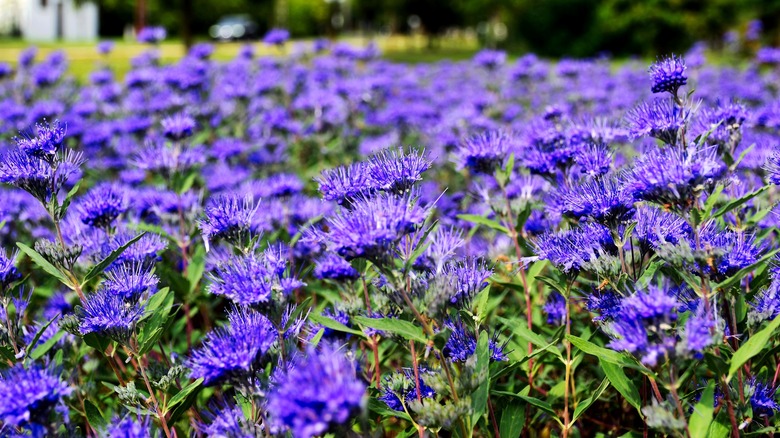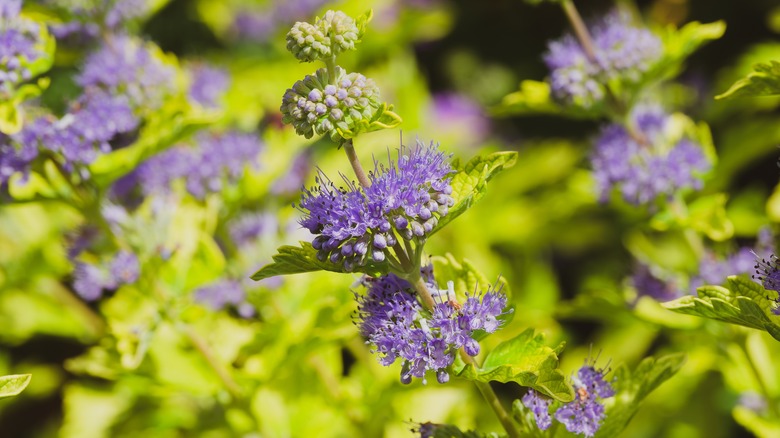The Blue-Flowering Companion Shrub You'll Want To Plant Near Joe Pye Weed
Joe Pye weed (Eupatorium dubium) is a common native plant that is famous for attracting many birds and pollinators. Its towering stalks topped with gorgeous mauve flowers are a lovely sight in summer. It grows about seven feet tall, though the 'Baby Joe' cultivar (Eupatorium dubium) is a dwarf version that tops out at five feet. As Joe Pye weed's flowers start to fade, the bright blue flowers of caryopteris shrubs come into bloom, also attracting many pollinators, making these excellent companion plants.
Though Joe Pye weed is not technically a shrub, its large size and sturdy root system make it seem like one. Once planted in your garden, it likes to stay put as its root system grows stronger, so choose its location carefully. This majestic plant looks great alongside the shorter, more rounded caryopteris, which grows up to three feet tall. Caryopteris comes in a few varieties, with flowers of vivid blue, purple, or white. Some cultivars have golden or variegated leaves.
Both of these plants like full sun, and should be planted in rich, loamy, neutral soil with a pH between 6 and 8. These plants attract many bees, butterflies, moths, and other pollinators throughout the summer. The caryopteris (also called bluebeard because of its deep blue flowers) is particularly attractive to honeybees and other kinds of bees for its abundant nectar and pollen. Sometimes bees hover around the bright flowers for hours, seemingly intoxicated by all the sweetness. Planting caryopteris can create a pollinator's paradise.
Watering needs
Planting these two low-maintenance perennials as companions works well because they require similar soil and sunlight conditions. However, their watering needs are slightly different, so this should be taken into account when caring for them. Caryopteris is fairly drought tolerant once established, and should only need supplemental watering during a period of prolonged drought or very hot weather.
Joe Pye weed, on the other hand, likes plenty of water, especially in hot weather. In its first year of growth, the soil should remain consistently moist. So be sure to plant these companions in soil that is well-draining, so that giving some extra water to Joe Pye weed won't negatively impact your caryopteris. Putting a layer of natural mulch around the base of both plants helps them regulate their moisture intake. Adding an extra inch or so of mulch around the Joe Pye weed will help it conserve water in the heat of summer.
It's also helpful to know the best watering technique for these plants. Joe Pye weed should be watered at the base of the plant, so the moisture it craves can go right to the roots where it's needed. In hot, sunny weather, the best time of day to water is in the early morning or at dusk. When your caryopteris is in bloom during hot weather, the bees and other pollinators drawn to the flowers will enjoy a light spray of water from your hose or sprinkler.
Pruning care
Both Joe Pye weed and caryopteris benefit from some pruning. Once your Joe Pye weed's flowers have faded and are about to go to seed, cut the stalks back to a few inches above the ground. You can also leave it intact for winter interest or shelter for birds and wildlife if you wish, then prune it back early in spring before new growth starts.
The caryopteris also needs pruning, and, like Joe Pye weed, this can be done in autumn when it starts to go dormant, or in early spring. This plant also produces flowers on new growth, or "new wood" as it's often called with woody perennial shrubs like this one. Similar to Joe Pye weed, the caryopteris can also be cut back to a few inches above the ground when you do your end of season garden clean up. This should generate new growth and plenty of flowers the following summer.
Following basic care tips for these two easy perennials will allow you to enjoy many years of beautiful, colorful blooms. Planting them as companions in the garden not only ensures plenty of late summer color but invites many happy pollinators to visit your garden. Growing pollinator plants side by side helps ensure the survival of important species.



